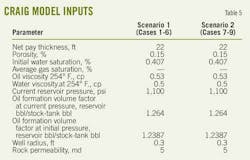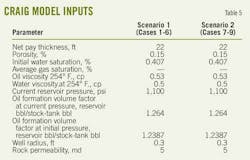Approach assesses waterflooding benefits in Egyptian oil field
View Article as Single page
Additional recovery
The cumulative production for the do nothing case was 0.4 million bbl for UB-2 and 0.77 million bbl for UB-3, as obtained from material balance runs. This assumed a 10 bo/d economic limit and a 500 psi average reservoir pressure at the abandonment.
The Craig model predicted the waterflooding production performance for each scenario. This model was used because it considers the spacing between the wells in the calculations,16 while the material balance does not take this into considerations.
The Craig model required the preparation of Excel spreadsheets. Table 5 summarizes the main input data used with the Craig model. The model indicated that the required constant injection rate was 450 b/d for UB-2 and 300 b/d for UB-2.
Table 6 summarizes the waterflood performance at water breakthrough. The results show that an injection rate of 450 b/d in UB-3 and 300 b/d in UB-2 yields production rates of about 360 b/d and 240 b/d, respectively.
Table 6 indicates that the distance between the injector and the producer strongly affects the breakthrough time. The time to breakthrough increases as the distances between the injector and the producer increases.
Craig Model results concluded the following:
• After breakthrough, the oil rate starts to decline and the water cut sharply increases.
• Waterflooding maintains the reservoir pressure in UB-2 and UB-3.
• Waterflooding in UB-3 was strongly recommended first because this unit had higher remaining oil in place relative to UB-2. The order of the three scenarios will improve recovery, maintain pressure, and provide a way to examine the communication of Well F-1 with the other wells.
• A full scale waterflood will recover about 2 million bbl.
References
1. Saputelli, L., and Nikolaou, M., "Self-Learning Reservoir Management," Paper No. SPE 84046, SPE Reservoir Evaluation & Engineering, December 2005.
2. Yesquen, S., Carro, J.L., and Lopez, L., "Integrated Reservoir Management for Life Extension of Mature and Marginal Oilfeild-Talara Basin, Peru," Paper No. SPE 97637, SPE Latin American and Caribbean Petroleum Engineering Conferences, Rio de Janeiro, June 20-23, 2005.
3. El Hawary, A.M., "Improving Transient Test Interpretation Results Using Reservoir Management," Master Thesis, Arab Academy for Science, Technology and Maritime Transport, College of Engineering and Technology, Cairo, June 2000.
4. Abu El Ela, M., "Data Analysis Methodology for Reservoir Management," Paper No. SPE106899, SPE Europec/EAGE Annual Conference and Exhibition, London, June 11-14, 2007.
5. Raza, S.H., "Data Acquisition and Analysis for Efficient Reservoir Management," Paper No. SPE 20749, JPT, April 1992.
6. Woods, E.G., and Osmar Abib, "Integrated Reservoir Management Concepts," Reservoir Management Practices Seminar, SPE Gulf Coast Section, Houston, May 29, 1992.
7. Trice, M.L. Jr., and Dawe, B.A., "Reservoir Management Practices," Paper No. SPE 22236, JPT, December 1992, pp. 1,344-49.
8. Wiggins, M.L., and Startzman, R.A., "An Approach to Reservoir Management," Paper No. SPE 20747, SPE ATCE, New Orleans, Sept. 23-26, 1990.
9. Haldorsen, H.H., and Van Golf-Racht, "Reservoir Management into the Next Century," Paper NMT 890023, Centennial Symposium at New Mexico Tech., Socorro, NM, Oct. 16-19, 1989.
10. Satter, A., et al., "Integrated Reservoir Management," Paper No. SPE 22350, 1992 SPE International Meeting on Petroleum Engineering, Beijing, Mar. 24-27, 1992.
11. Sarem, A.M., "Questions and Answers: Reservoir Management Panel Discussion," Paper No. SPE 20781, SPE ATCE, New Orleans, Sept. 23-26, 1990.
12. Satter, A., and Thakur, G.C., Integrated Reservoir Management, PennWell Books, Tulsa, 1994.
13. Thakur, G.C., "Implementation of Reservoir Management Program," Paper No. SPE 20748, SPE ATCE, New Orleans, Sept. 23-26, 1990.
14. Abu El Ela, M., "Integrated Approach Recommends Redevelopment Plan," OGJ, Aug. 7, 2006, p. 55.
15. Popa, A., Cassidy, S., and Opsal, S., "Implementing Integrated Solutions for Reservoir Management: San Joaquin Valley Case Study," Paper No. SPE 144468-MS, SPE Western North American Region Meeting, Anchorage, May 7-11.
16. Craig, F.F. Jr., Geffen, T.M., and Morse, R.A., "Oil Recovery Performance of Pattern Gas or Water Injection Operations from Model Tests," Transactions AIME, Vol. 204, 1995, pp. 7-15.
The author
Displaying 4/4
View Article as Single page
More Oil & Gas Journal Current Issue Articles
More Oil & Gas Journal Archives Issue Articles
View Oil and Gas Articles on PennEnergy.com




